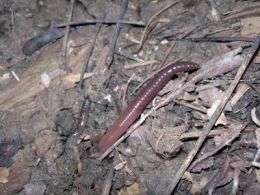Earthworms. Credit: Photo courtesy of Cliff Johnston, Purdue University Department of Agronomy
(Phys.org) —A combined team of researchers from the U.S. and China has found evidence to suggest that earthworms actually sequester more CO2 than they cause to be released into the atmosphere. In their paper published in the journal Nature Communications, the researchers describe experiments they conducted in a lab using two kinds of earthworms and various soil types in an attempt to discern how much CO2 they sequester.
Scientists know that soil contains a lot of carbon, prior research has found that up to a fifth of all carbon emissions into the atmosphere come from common dirt. But it doesn't happen spontaneously—earthworms and microbes break down leaves and other liter releasing the carbon in them. One recent study concluded after reviewing over 200 published studies, that earthworms alone are responsible for increasing the amount of carbon released from the soil by up to 33 percent. In this new effort, the research team suggests that earlier studies have not taken proper consideration of the amount of carbon that earthworms sequester.
When earthworms eat liter that makes its way into the soil, some carbon is released right away—but not all of it, some is retained in the material that is eventually digested. Once digested that material is deposited back into the soil and cannot escape, which means it's been sequestered by the worm. But because it's a slow process, it's not been studied very carefully. The researchers in this latest study set up soil in various states in a lab and then released two kinds of earthworms into most of them (some were left without worms to serve as a control) along with liter. They then let the samples sit for a month as they quietly monitored CO2 emissions.
In analyzing the results, the researchers found that the worms caused the release of a lot of CO2 initially, but then things tapered off. They also found that the soil without the worms in it emitted just as much CO2 as that with it. And, there was no difference in emissions between the two types of earthworms. In analyzing the results, the team worked up a formula to separate out how much CO2 was being emitted and how much was being sequestered—their calculations showed that more of it was apparently being sequestered in the soil than was being released into the air.
The team acknowledges that their findings are preliminary, and suggest that more research be conducted, especially over much longer periods of time. Their research has convinced them it might just turn out that earthworms are sequestering a lot more CO2 than they are causing to be released.
More information: Earthworms facilitate carbon sequestration through unequal amplification of carbon stabilization compared with mineralization, Nature Communications 4, Article number: 2576 DOI: 10.1038/ncomms3576
Abstract
A recent review concluded that earthworm presence increases CO2 emissions by 33% but does not affect soil organic carbon stocks. However, the findings are controversial and raise new questions. Here we hypothesize that neither an increase in CO2 emission nor in stabilized carbon would entirely reflect the earthworms' contribution to net carbon sequestration. We show how two widespread earthworm invaders affect net carbon sequestration through impacts on the balance of carbon mineralization and carbon stabilization. Earthworms accelerate carbon activation and induce unequal amplification of carbon stabilization compared with carbon mineralization, which generates an earthworm-mediated 'carbon trap'. We introduce the new concept of sequestration quotient to quantify the unequal processes. The patterns of CO2 emission and net carbon sequestration are predictable by comparing sequestration quotient values between treatments with and without earthworms. This study clarifies an ecological mechanism by which earthworms may regulate the terrestrial carbon sink.
Journal information: Nature Communications
© 2013 Phys.org























